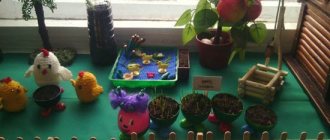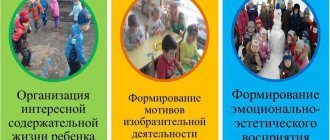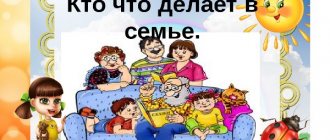Environmental project in kindergarten. Second junior group
Experimental research project for junior group 2 “Nature is our home.
There is no need for garbage in it!” Motto: We want the earth to bloom, And babies to grow like flowers. So that ecology becomes for them. Not science, but part of the soul PROJECT PASSPORT Type of project: information and research Content: child and nature conservation Project participants: children - teachers - parents Number of participants: collective Duration of project implementation: Long-term (September 2021 - May 2021) Problem: pollution of nature with household waste Hypothesis: what will happen to the environment if garbage is not recycled for reuse. 1. Relevance of the problem : By decree of the President, 2017 in Russia has been declared the year of ecology, which is especially important for us, since one of the areas of our kindergarten is environmental education. The work is carried out in the following areas: 1. Nature to man (where children's attention is focused on the aesthetic and health-improving significance of nature). 2. Man - nature (where positive and negative human activities are shown). 3. How to preserve nature (where children learn about the rules of nature conservation). 4. We are defenders of nature (participation in environmental activities). Man cannot live without using the resources of nature. And it is ecology that teaches how to use nature without causing damage to it. Most preschoolers love to walk in nature, go with their parents to the park, river, and go on excursions. But what upsets everyone is that there is a lot of garbage almost everywhere. The children began to wonder: Where does so much garbage come from? How garbage affects nature. Where is the garbage taken? Is it possible to make something useful and beautiful out of garbage? To answer these childish questions and try to solve the “garbage problem,” we developed the project “Nature is our home. There is no need for garbage in it!” 2. Project goal: 1. Finding out the reasons for the appearance of garbage; 2. Conducting an experiment “How garbage decomposes”; 3. Study of methods of sorting, processing and disposal of waste; 4. Carrying out the campaign “Collecting waste paper”, “Second life of things”, “Garbage collection”. Project objectives: To give children an idea of the types of household waste and their properties; about the danger of household waste to human life and living organisms. To clarify children’s ideas about the main sources of land, water, air pollution, its consequences, and measures to prevent pollution. Find ways to reuse household and household waste. To foster an active citizenship in protecting the environment, to expand children’s knowledge about the interdependence of the natural world and human activities, and the desire to communicate with nature without polluting it. To stimulate interest in research activities, to experimentally identify which waste decomposes faster, to improve the ability to operate with existing knowledge, to generalize, to draw conclusions Stages of project implementation Stage I - preparatory 1. Collection and analysis of literary sources on the topic. 2. Design of didactic materials in accordance with the project plan. 3. Questionnaire “Garbage in our city.” 4. Development of tips for parents “How to handle waste at home?” Stage II - organizational 1. Conduct conversations, classes, games to study the properties and qualities of materials: glass, plastic, metal, paper, rubber. 2. Introduce children to the problem of environmental pollution by household waste near their home, on their street, in kindergarten. 3. Conduct an experiment “What does the earth “eat”, and why does it get sick?” Stage III – practical activity 1. Reading S. Mikhalkov’s “Walk”, A. Anishin’s “At the city cleanup”, E. Smirnov’s “Let’s decorate the earth.” 2. View the slide show “Garbage pollutes our nature”
3. Watching a cartoon from the “Smeshariki” series - “About a cow, which, due to poisoning of the air and water, gave gasoline instead of milk,” “The Life of Garbage,” “The Adventure of Leopold the Cat and His Friends in the Yard.” 4. Conversation “Garbage underfoot is dangerous.” Purpose: To provide an understanding of the dangers of garbage to nature and humans. 5. Didactic game “Sorting Garbage” Purpose: to distinguish and name materials, to form an idea of environmental protection through the rational use of unnecessary items and their recycling.
6. S/R game “Going shopping” Purpose: To teach how to choose goods in reusable packaging
7. Thematic observations. For several days, we drew the children's attention to the fact that we throw out garbage every day. Where does he go? What do parents do with garbage? How do you deal with waste in kindergarten? Is it possible to see trash in the vicinity of the kindergarten? Where does it come from? Are there trash cans and trash cans near the garden?
8. Experimental and practical activities. Goal: to help children understand that they should not litter. This affects nature and human health. Learn to use unnecessary items. Using them to create toys, interior decorations, and playgrounds. Paper and cardboard can be taken to recycling centers, where it is turned into new albums, packaging boxes, napkins, wrapping paper and toilet paper. a) Experiments with objects made of different materials (Glass, iron, paper, rubber, plastic). Goal: to experimentally establish the shape, color, properties, methods of their use. b Experiment “Making new paper.” Purpose: To show that even at home, pieces of paper can be reused.
c) Experience “Where does garbage come from and where does it go?”, preschoolers found out where garbage comes from and where it goes. Children threw garbage at home and in kindergarten into a bag. Then they took it to a container on the street and saw that a garbage truck was emptying the container and taking it to a special landfill. The children learned that people do not live near special landfills, because there are a lot of microbes, poisonous gases, and heavy metals there. All this has a detrimental effect on human health and the environment. Therefore, you cannot throw out garbage anywhere, or make unauthorized dumps in forests, ponds, or fields. d) Experience “What the earth “eats” and what makes it sick”, the students decided to find out whether garbage disappears in nature or remains forever. In the fall, in September, the children, together with the teacher, buried some types of household waste (paper, plastic cup, metal can, glass, pieces of wood, leaves) on the territory of the kindergarten and put up signs. In May of the following year, having dug up the garbage, the preschoolers found out that food waste and leaves, pieces of wood had disappeared, but a plastic cup, a metal can, glass, and paper remained in the ground in the same condition. As a result of the experiment, the students concluded that after outdoor recreation, food waste can be buried, and everything else should be collected and thrown into a special container.
d) Experience “How to reduce the amount of waste?” During conversations on the topic “Garbage must be separated,” the students learned that some waste can be recycled; to do this, they just need to sort the garbage at home and take it to special points. 1.The first solution to the problem was waste sorting. Children, with the help of adults, sorted garbage for its subsequent recycling and found possible options for recycling garbage, taking into account the least harm to nature and people 2. The second option for solving the problem was proposed by adults to use things and objects economically. For example, you can write and draw on two sides of a sheet, on the second side of a written sheet. 3.The next solution to the “Buy wisely” was suggested by the pupils’ grandmothers. This means that when you go to the store, you can take bags from home, select and buy shelf-stable products without unnecessary packaging. A clear confirmation of the correctness of this approach was the role-playing game “Shopping for groceries?” The children split into two groups to go grocery shopping. Participants in the first group took shopping containers with them: glass jars, bags, and tried to choose the right products in reusable packaging (glass jars, plastic boxes), while participants in the second group bought all products in disposable packaging. Upon returning home, the participants in the second group unpacked the groceries and threw away the packaging material. As a result, their trash can was full, unlike the bin of the first group of children.
Using food waste to feed animals and fertilize the land.
5. And finally, the most creative solution to the problem is “Second Life”. As a rule, over time, some things become unnecessary, and the only way to get rid of them is to throw them away. But this is not the best option. You can use things to throw away to make toys, gifts or interior items: panels of dried flowers (on candy boxes), paper baskets, gift boxes, attributes for role-playing games, interior design of playgrounds for walks, material for experiments and experiments in a corner of nature.
9. Questioning parents. Of the 20 parents surveyed, 70% accumulate the largest amounts of paper and plastic waste per week, 25% accumulate food waste, and 5% accumulate glass and batteries. 80% do not sort waste and throw it in trash cans. And 20% are sorted, selecting food waste for feeding pets. Only 10% of respondents use unnecessary items for crafts with children and design of their yard. 90% know the dangers of household waste. Only 15% tell children about the dangers of household waste. 50 50% then pick up trash after walks in nature. 30% involve children in cleaning the area near their home and picking up trash after themselves. 65% are not satisfied with the organization of household waste disposal in our city. 10.Environmental campaign “Let’s give nature purity!” 11. Exhibition “Miracles for people from unnecessary things” CONCLUSION: 1. Reading fiction, didactic, role-playing games, excursions to the park, helped preschoolers realize the seriousness of the garbage problem 2. As a result of research activities and observations, we came to the conclusion that waste of artificial origin litters the environment, it must be collected in specially designated places (garbage cans, etc.) or used as recyclable materials for making crafts from waste material. 3. We expanded preschoolers’ knowledge about the dependence of the natural world and people, preschoolers learned about the possibility of recycling waste, and experimented. Now they want to be more careful about nature, to preserve and protect it. Literature: 1. Aksenova, Z.F. Enter nature as a friend. Environmental education of preschool children. – Moscow: Sphere shopping center, 2011. – 128 p. – (Teacher's Library). 2.Andrienko, N.K. Game in environmental education of preschoolers // Preschool pedagogy. - 2007. - No. 1. - P.10-12. 3. Voronkevich, O.A. “Welcome to ecology” - modern technology of environmental education for preschool children // Preschool pedagogy. - 2006. - No. 3.- P. 23-27. 4 Nikolaeva S.N. Young ecologist: Program for environmental education of preschoolers. – M.: Mozaika-Sintez, 2004. 5. Nikolaeva, S.N. Environmental education of younger preschoolers. A book for kindergarten teachers. - M.: Mozaika-Sintez, 2004. - 96 p. 6. Ryzhova N. “Our home is nature.” Program for environmental education of preschool children // Preschool education. 1998. No. 7. pp. 26–34.
We recommend watching:
An environmental project in a kindergarten in an early age group A project in the junior group of a kindergarten on environmental education An environmental project in the second junior group of a kindergarten “Tales from the Garden” Poems on ecology for older preschoolers 6-7 years old
Similar articles:
Scenario of the city festival of children's creativity
Game program on ecology for preschoolers
Junior group. Early childhood, nursery. Children 1-4 years old
Short-term project on life safety of young children in nature “Dangerous - not dangerous” Municipal budgetary preschool educational institution “Kindergarten No. 15”
Smolensk Educator: Borisova Natalya Nikolaevna Smolensk 2021
“Dangerous - not dangerous”
Relevance. One of the areas of development and education of children is social and communicative...
Project "Ecolyats - preschool children" in an early age group As part of the project " Ecolyats - preschool children "
in the MADO "Kindergarten No. 8
"Sunny City"
in the city of Engels, Saratov region, in group No. 1 various
environmental : Conversations: "Feed the birds in winter"
,
"Rules of behavior in the forest"
. All these activities allow...





